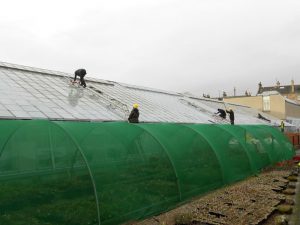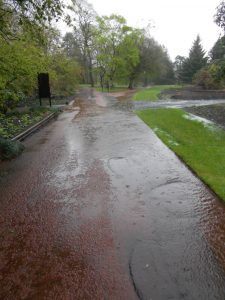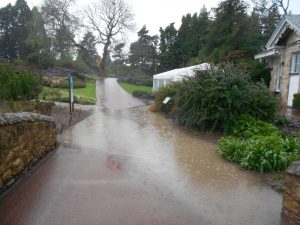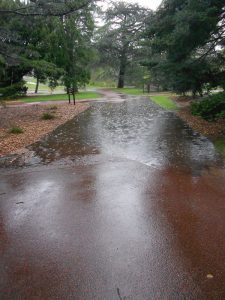A very mild end to 2011, we recorded 12.5oC on the 31st December. On the 3rd January 2012 Edinburgh recorded wind speeds of over 100mph. The highest wind speeds for more than thirty years. A violent storm blew through from the early hours of the morning reducing 34 trees to matchwood and blowing out 600+ panes of glass from the glasshouse ranges. The storm and resulting damage led to closure to visitors for two days on the 3rd and 4th January.
The month continued with few frosts and became drier and settled. During early February when most of England and the north of Scotland were covered in snow Edinburgh basked in cold but clear sun filled days.
February continued dry and relatively mild. This gave us an ideal opportunity to progress the storm damage clear up and replanting.
Two downsides to the mild weather were the need to irrigate newly planted material through this period of low rainfall, but also the rapid growth of annual weed seedlings. At the end of February these were not noticeable; yet by the first week in March we appeared to have a green sheen covering bare, unmulched soil.
A dry warm spring; a record high temperature of 22.8oC was set for Scotland in March on Sunday March 25th; then 22.9oC on Monday 26th in Aboyne. Higher again on the 27th with Aboyne recording 23.6oC.
Everywhere is so dry, new plantings are desperate for regular irrigation, grass seed not germinating.
April and the temperature plummeted. It was a cold, dismal and continually wet month. The wettest April for 100 years according to weather records. To compound things, late frosts cut back emerging foliage and flower buds. A particularly extensive example of frost damage affected the Azalea lawn. Two cultivars, ‘Sunte Nectarine’ and ‘Frills’ caught the early morning sun causing the foliage to shrivel back.The wettest April for 100 years according to weather records
When May arrived we thought an improvement in the climate would occur; how wrong we were. It was persistently miserable with light levels remaining low even with the lengthening days. The woody plants flowered reliably and the scents drifting on the air lifted spirits. It was not until the 22nd of May that temperatures again reached the low 20’s. Eight weeks is a long wait for sunshine and warmth, both for the plant collection and for those of us who maintain the Garden.
Mid-summer and we again experienced a long cool wet day. June continued to be wet and miserable. It was a dull month with sunshine hours reduced due to cloud cover. When the sun did break through there was intensity to it and lawns dried enabling mowing to progress. Our rainfall figures showed we had almost double the average for June.
Slugs and snails increased exponentially with the wet weather, in the evenings moving upwards from their shelter in the layer of thatch to the surface of the lawn.
Growth on hedges and extension growth on the majority of woody plants was phenomenal. Growth there may have been on Buddleja globosa yet this growth did not terminate in clusters of flowers.
Red Thread fungal infections were visible on the front lawns, a sure sign of a continual wet surface. Plantains grew bigger and Buttercups thrived in the lawns, there was a visible change in the vegetation mix where the lawns remained wet. We grew the largest Plantains I have ever seen. Admittedly these accidental seedlings were at the edge of a border bounded by a semi-permanent puddle. There was a poor set on fruit, including glasshouse tomatoes due to the lack of flight opportunities for pollinating insects with the cooler temperatures and continual rain. When these fruits did ripen they had a poor taste with none of the usual sweetness and to compound it, a heavy texture.
August ended with a frost overnight in Braemar. Then on September 3rd 25oC was recorded in Aberdeen, the highest September temperature recorded in the city.
At the Garden the first white grass frost occurred on 22nd September, recording -2.11oC; this a whole month earlier than in 2011. On Tuesday 25th we closed the Garden due to storm force winds and heavy rain, the previous day thunder and lightning had woken us early.
Whatever the weather the Hydrangea’s loved it; this season the mop heads were as large and as colourful as I have previously seen; lasting well into October.
Dismal news regarding conkers; the Scottish championship was cancelled in mid-October due to the lack of conkers. Certainly, the Aesculus hippocastanum on the north boundary of the Garden which always produces a crop was barren this year.
The early frosts and stormy weather conspired against plentiful autumn colour this year. The abscission layer was weakened by the early frosts and then canopies took a severe battering through stormy days and nights. Leaves fell to the ground without amassing the seasonal shades of autumn. Acer nikoense opposite the Palm House produced the best colour in the garden this season; vivid reds spread through the whole canopy.
Around the middle of November as a wave of mild weather swept in from the west we experienced a plague of midges. Working in the Garden around the 13/14th these drove us to distraction. In the east we are rarely troubled by these, certainly not so late in the season. A benefit of the mild weather was the heavy scent from the earliest flowers of Viburnum x bodnantense drifting on the air in the early mornings.
This has been a wet year, after predictions of a fine summer and drought the rain continued to fall. It resulted in the garden closing due to flooding, something we have not done before, but when all the access paths had areas that were under water in one area or another it was not sensible to open to visitors. As the weather got colder the rain turned to snow, the first fall dusting the Garden overnight on Sunday 2nd December. The cold weather was a feature of the first half of the month and then the second half, as we began 2012, turned mild, 11.6oC on the 31st. When have you known sweet peas in flower for Christmas before? I even have strawberries flowering and forming fruit in the garden at home.
Total rainfall for the year to 8.30am on the 31st December is 972.7mm. This compares to the long term Edinburgh average of 690mm, (remember those dry summers and the warmth of the 1970’s and 1980’s?) Previously the wettest year had been 2008 with a rainfall total of 896.9mm.
The images attached represent this year’s climatic conditions experienced at the Garden. Let us hope for a more benign climate in 2013. Best wishes for the New Year.




